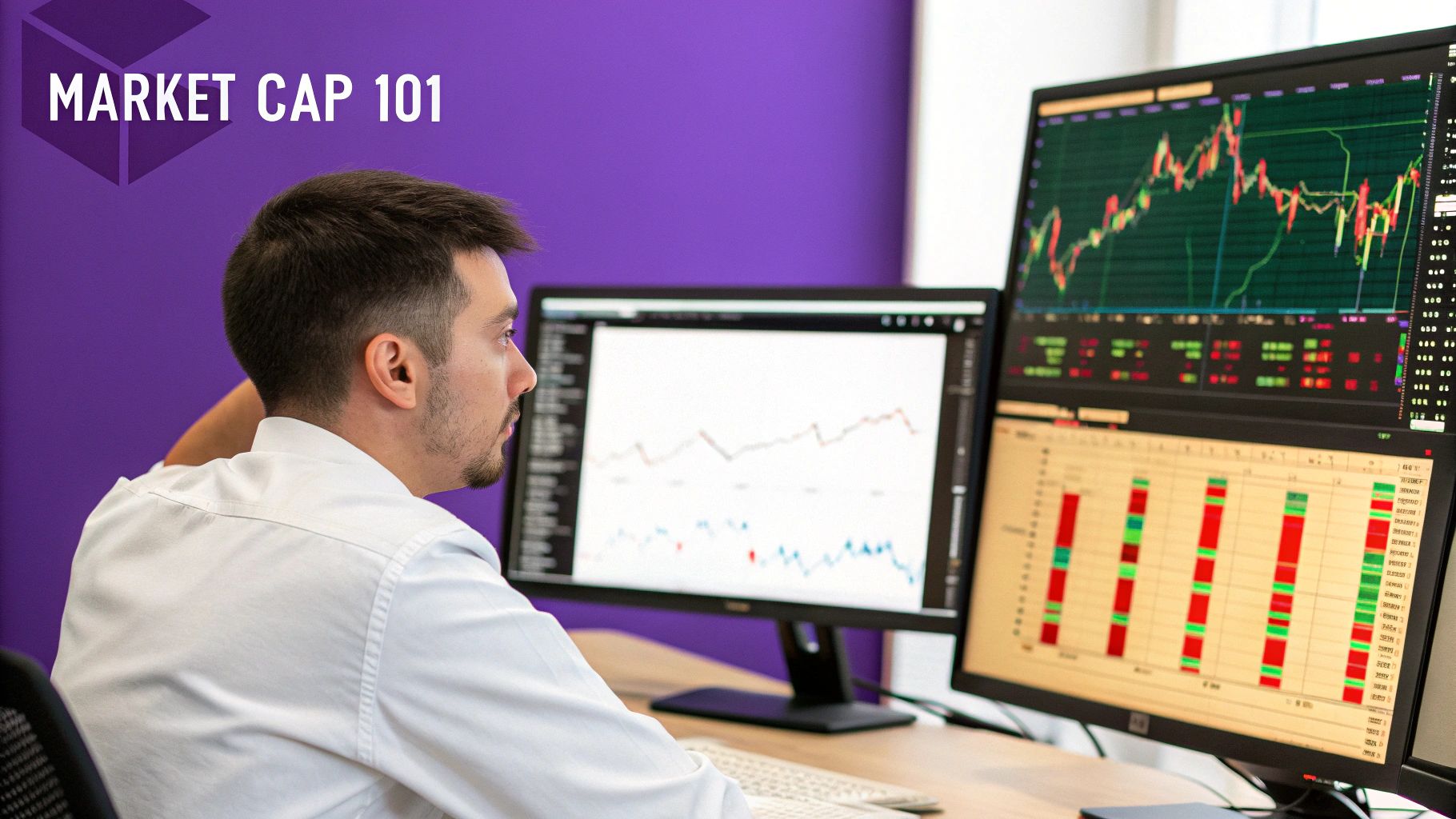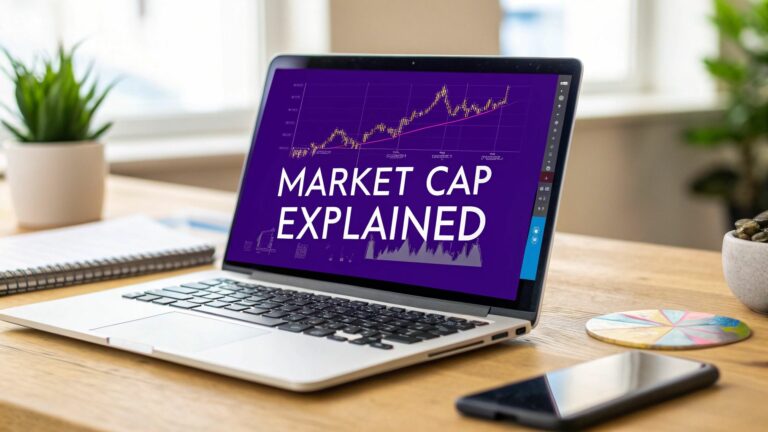Ever heard the term "market cap" thrown around in crypto discussions? It’s one of the first metrics you’ll encounter, and for good reason. Simply put, crypto market cap is the total value of all of a cryptocurrency's coins currently in circulation. It’s a quick calculation: multiply the coin's current price by its circulating supply. The result gives you a powerful snapshot of its relative size and perceived stability in the market.
What Is Crypto Market Cap Really Telling You

When you see a crypto’s market cap, it’s tempting to picture it as a massive vault filled with cash. That's a common misconception. A much better way to think about it is like a company's valuation on the stock market—it’s not a pile of money, but a reflection of the collective market perception and the project's overall scale.
Essentially, market capitalization is a snapshot of a cryptocurrency's total value at a single moment in time. This makes it an incredibly useful yardstick for quickly gauging how one project stacks up against another.
Think of it like valuing a whole neighborhood. You wouldn't just look at the price tag on a single house. Instead, you'd multiply the average house price by the total number of houses to understand the neighborhood's overall value. Crypto market cap applies the same logic, giving you the "neighborhood value" of a digital asset.
Market Cap in the Broader Crypto Economy
This metric is powerful because it adds crucial context to a coin's price. A $1 coin isn't automatically a better deal than a $1,000 coin. If the first one has billions of coins in circulation and the second has only a few thousand, the market cap will reveal which project is actually larger and, often, more established.
The total crypto market cap—the combined value of all cryptocurrencies—has seen some wild swings. After a tough downturn in late 2022, the market mounted a strong comeback. By March 2025, estimates placed the total market cap around a staggering $3.8 to $3.9 trillion USD. For a deeper dive into these trends, check out Statista's crypto market value analysis.
Key Takeaway: Think of market cap as a gauge for a crypto’s relative size and stability. A higher market cap often suggests lower volatility, while a lower cap can indicate higher risk but also greater growth potential.
To trade smartly, it's vital to know how market cap stacks up against other key metrics. Each one tells a different part of the story.
Key Crypto Metrics At a Glance
The table below breaks down the most common metrics to help you understand what each one really means for your analysis.
| Metric | What It Measures | What It Tells You |
|---|---|---|
| Market Cap | Current Price x Circulating Supply | The project's overall size and relative stability. |
| Price | The cost of a single coin or token. | The entry cost for one unit, but little about overall value. |
| Trading Volume | The total value of coins traded in a period. | The project's liquidity and current investor interest. |
By looking at these metrics together, you get a much clearer picture of a project's health and potential than by focusing on price alone.
The Simple Math Behind Market Cap

You might think calculating a crypto’s market cap involves some kind of complex wizardry, but it’s surprisingly simple. In reality, it boils down to basic multiplication that gives you a powerful, at-a-glance measure of a project's overall size.
Here's the formula in all its glory:
Market Cap = Current Coin Price x Circulating Supply
This simple equation tells us the total theoretical value of all coins that are actually available to the public right now. Let’s pull back the curtain on each part of that formula.
Breaking Down the Formula
First up is the Current Coin Price. This is exactly what it sounds like: the live price one coin is trading for on exchanges. It’s a dynamic number, constantly shifting based on the tug-of-war between buyers and sellers across the globe.
Next, you have Circulating Supply. This is the key metric. It represents the total number of coins that are actively in the hands of the public and available on the market. We use this figure because it reflects the real-world supply that people can actually trade.
It's absolutely critical not to mix this up with other supply figures you might see:
- Total Supply: This includes every coin ever created, minus any that have been verifiably "burned" or destroyed. It often counts coins that are locked up and not available for trading.
- Max Supply: This is the hardcoded, absolute limit on the number of coins that can ever exist for a particular crypto.
Using the circulating supply gives you the most honest and accurate picture of a crypto's current valuation. If you're looking to brush up on more core concepts like this, the vTrader Academy is a great place to start.
So, let's put it into practice. If a made-up "ExampleCoin" is trading at $2.50 and has a circulating supply of 40 million coins, its market cap is a cool $100 million. That straightforward math gives you a solid benchmark to compare its standing against thousands of other projects.
Using Market Cap to Guide Your Investment Strategy
Now that you've got the mechanics down, let's talk about putting market cap to work for you. Thinking about crypto market cap isn't just a mental exercise; it’s a seriously practical way to gauge risk and sniff out potential growth. By sorting coins into different buckets, you can build a framework that matches your investments to your financial goals and what keeps you up at night.
This infographic breaks down why this metric is so crucial for building a smart strategy.

As the image shows, market cap gives you a clear pecking order for stability versus potential—something every trader needs to make sharp decisions.
Sorting Cryptos by Size
The crypto world is pretty much split into three tiers based on market cap. Getting a handle on these categories is your first real step toward putting together a balanced portfolio.
-
Large-Cap: These are the giants, the "blue-chips" of the crypto space like Bitcoin and Ethereum. We're talking about projects with market caps of $10 billion or more. Their sheer size usually means more stability, better liquidity, and a proven history, which is why they’re often the first stop for new investors.
-
Mid-Cap: In the $1 billion to $10 billion range, you’ll find the rising stars. These projects have already proven their worth but still have plenty of runway for growth. They're definitely riskier than the large-caps but offer a potent mix of upside potential and real-world utility.
-
Small-Cap: Anything under $1 billion falls into this category. These are your high-risk, high-reward plays. Many are fresh-faced projects or altcoins that could either go to the moon or fizzle out entirely. The growth potential here can be explosive, but so is the volatility, so doing your homework is non-negotiable.
By classifying assets this way, you can strategically balance your portfolio. For instance, a larger allocation to large-caps provides a stable foundation, while a smaller, calculated investment in small-caps could target higher returns.
This tiered approach is a game-changer for managing risk. For instance, savvy investors use large-cap assets not just for potential growth but also for generating income. If earning rewards on established players sounds interesting, you can learn more about crypto staking opportunities on vTrader.
Ultimately, this framework helps you graduate from just buying coins to building a truly thoughtful investment strategy.
How Market Dominance Shapes the Crypto World
The crypto market is much more than just a list of individual digital assets. It’s a deeply interconnected space where the biggest players can cause ripples that affect everyone. This is where the idea of market dominance becomes so important.
Picture the entire crypto market cap as a massive pie. Market dominance simply tells you how big of a slice any single cryptocurrency, like Bitcoin, has claimed.
Reading the Signals
Understanding this dynamic is crucial for any trader. When a dominant coin like Bitcoin makes a big move, it rarely happens in a vacuum. Its sheer weight means its price shifts often dictate the mood for the entire market. A surge in Bitcoin's price, for instance, can drag many other cryptocurrencies—known as altcoins—up along with it. On the flip side, a sharp drop can spark fear across the board.
Shifts in dominance can offer powerful clues about where the market is headed. A rising Bitcoin dominance percentage often signals that investors are scrambling for its perceived safety, a classic "flight to quality" during uncertain times. But when its dominance starts to fall, that can be a signal of something exciting on the horizon for traders.
This shift can sometimes signal the start of an "altcoin season"—a period where smaller, alternative coins begin to outperform Bitcoin as investor confidence grows and they seek higher returns. Staying on top of these trends is crucial, and our vTrader news hub provides real-time updates to keep you informed.
The influence of the top players is undeniable. For a real-world snapshot, on March 21, 2025, Bitcoin (BTC) and Ethereum (ETH) together accounted for over half the market cap of the top 125 coins. Bitcoin's market cap was sitting at roughly $2.39 trillion USD, while Ethereum’s was about $432 billion USD—a clear sign of their central role in the crypto economy. You can explore more data on global crypto market share on Statista to see this in action.
The Hidden Dangers of Relying on Market Cap Alone
While market cap is a fantastic starting point for sizing up a crypto project, treating it as the ultimate measure of value is a classic rookie mistake. Any seasoned investor knows this metric has some serious blind spots that can lead you straight into a bad trade if you aren't careful.
One of the biggest traps is just how easily it can be manipulated, especially with small-cap coins that have thin trading volume. In these corners of the market, a few bad actors can orchestrate a "pump-and-dump" scheme, artificially jacking up the price—and the market cap with it. Once they cash out, everyone else is left holding the bag.
What Market Cap Doesn't Tell You
At its core, market cap is just a simple calculation, not a seal of quality. It tells you absolutely nothing about the real-world strengths or fatal flaws of a project.
- Technology and Utility: It won’t tell you if the project's code is a masterpiece or a mess, or if it actually solves a problem anyone cares about.
- Community and Development: The metric completely ignores the passion of the community, the hustle of the developers, or the long-term vision of the team.
- True Liquidity: A massive market cap doesn’t guarantee you can actually sell your holdings without sending the price into a nosedive.
Investor Insight: Relying only on market cap is like judging a car by its sticker price. You wouldn't buy it without checking the engine, the mileage, or the safety report, would you? It's just one number in a much bigger story.
The crypto market's immense scale and lightning speed make doing your homework more critical than ever. Not long ago, the global crypto market cap surged to roughly $3.9 trillion USD, with data shifting every second to reflect nonstop trading. You can watch these hypersensitive market movements for yourself and see how global crypto charts change on TradingView.
To get the full picture, you have to look beyond a single number. Combine market cap with trading volume, developer activity, and the project's core fundamentals. This balanced approach is the key to protecting your capital and a core principle behind our platform's design. You can learn more about our commitment to user protection in the vTrader refund policy.
Answering Your Top Questions on Crypto Market Cap
Even when you think you’ve got a handle on market cap, a few tricky questions always seem to pop up. It’s a metric with plenty of nuance, capable of tripping up even seasoned crypto traders. Let's dig into some of the most common points of confusion to sharpen your analysis.
Does Market Cap Equal Real Money Invested?
No, and this is probably the single most important thing to get straight. A project's market cap is a theoretical number—it’s just the current price multiplied by the number of coins in circulation. It is not a measure of how much actual cash has been poured into a cryptocurrency.
Here's a simple way to think about it: imagine if every single person holding a token tried to cash out all at once. That sudden flood of supply hitting the market would send the price through the floor. The total amount of money they’d actually get back would be a fraction of the market cap figure. It's a yardstick for comparing the relative size of different projects, not a digital bank statement.
Investor Takeaway: Market cap shows perceived value, not invested cash. Use it to size up one project against another, but never confuse it for a project's cash reserves or real-world liquidity.
What Is Fully Diluted Valuation vs. Market Cap?
This is another key comparison that tells a bigger story about a project's future. While market cap works with the circulating supply (the coins out there today), Fully Diluted Valuation (FDV) uses the total or max supply—every single coin that could ever possibly exist.
Essentially, FDV gives you a glimpse into a potential future valuation if every token was circulating at today’s price. A massive gap between a project's market cap and its FDV can be a huge red flag. It’s a warning sign of potential price dilution down the road as millions, or even billions, of new tokens are unlocked and released into the market.
Can a Low-Priced Coin Have a High Market Cap?
Absolutely. A coin's price, on its own, is one of the most misleading stats in all of crypto. The real story is in the relationship between price and supply, which is exactly why market cap is a much better tool for judging a project's actual scale.
- Example 1: A coin trading at just $0.01 but with 100 billion tokens in circulation has a huge market cap of $1 billion.
- Example 2: In contrast, a coin priced at $1,000 with only 10,000 tokens in existence has a much smaller market cap of just $10 million.
This simple breakdown shows why you can't judge a crypto by its price tag. If you have more questions, be sure to check out the vTrader FAQ page for more insights.
Ready to put your knowledge into practice? With vTrader, you get commission-free trading, advanced analytical tools, and real-time data to make smarter decisions. Join a platform designed to empower your crypto journey. Sign up today and start trading with zero fees at https://www.vtrader.io.

Steve Gregory is a lawyer in the United States who specializes in licensing for cryptocurrency companies and products. Steve began his career as an attorney in 2015 but made the switch to working in cryptocurrency full time shortly after joining the original team at Gemini Trust Company, an early cryptocurrency exchange based in New York City. Steve then joined CEX.io and was able to launch their regulated US-based cryptocurrency. Steve then went on to become the CEO at currency.com when he ran for four years and was able to lead currency.com to being fully acquired in 2025.


